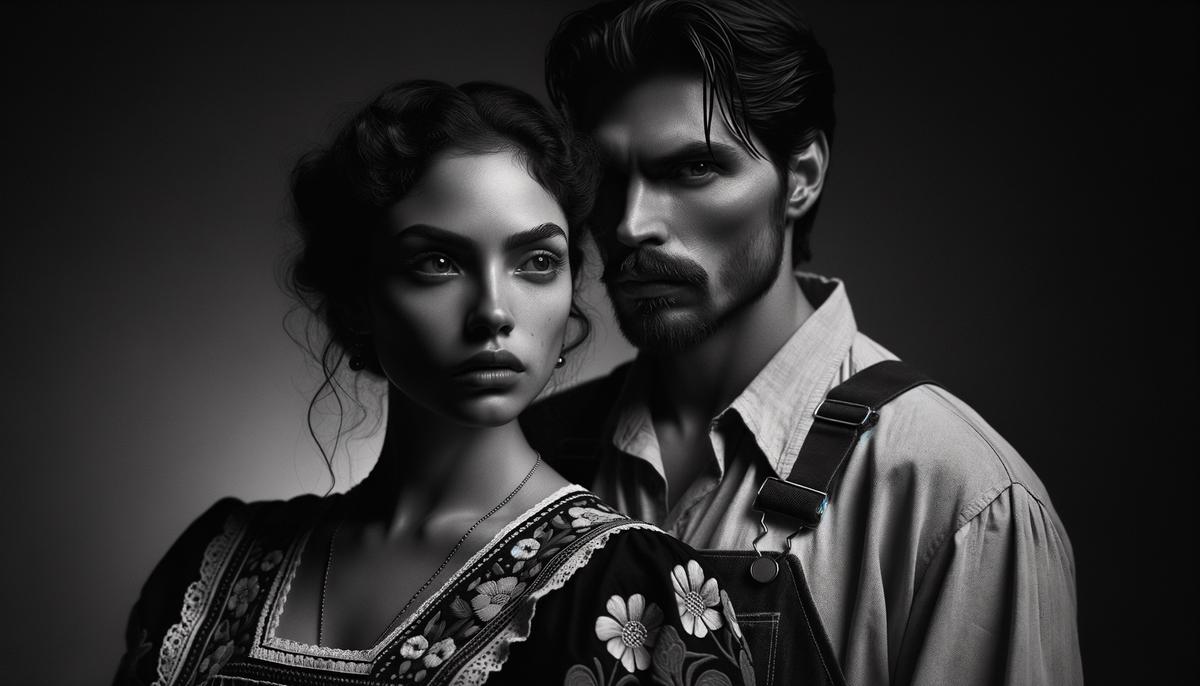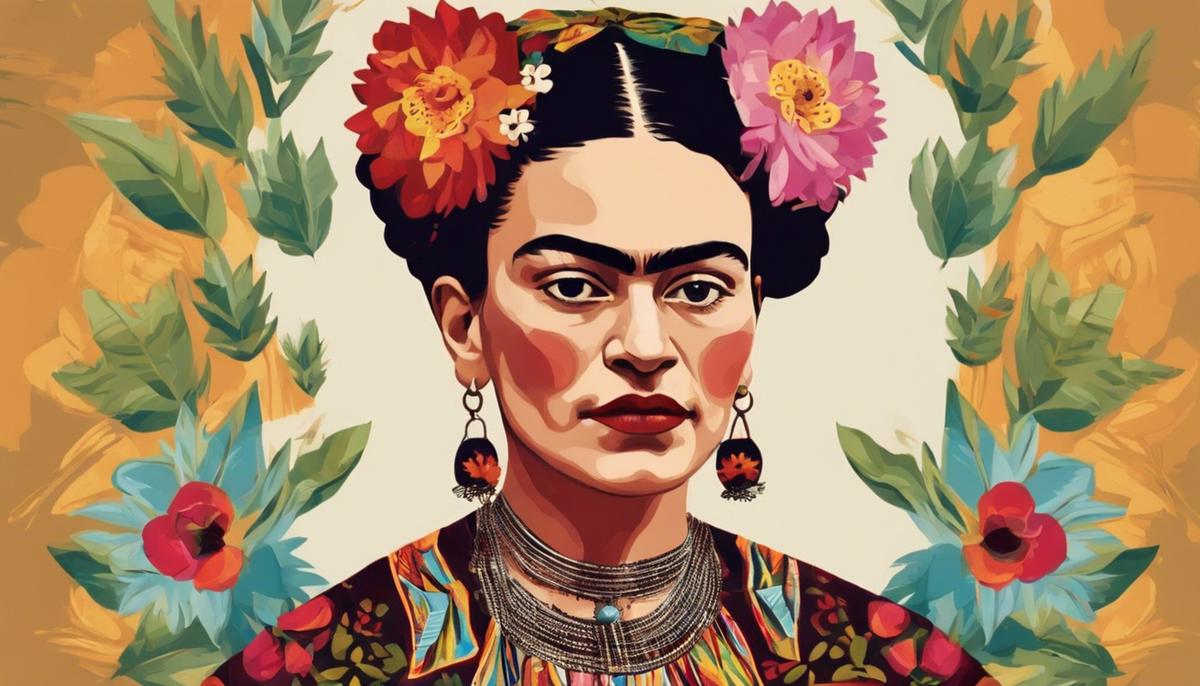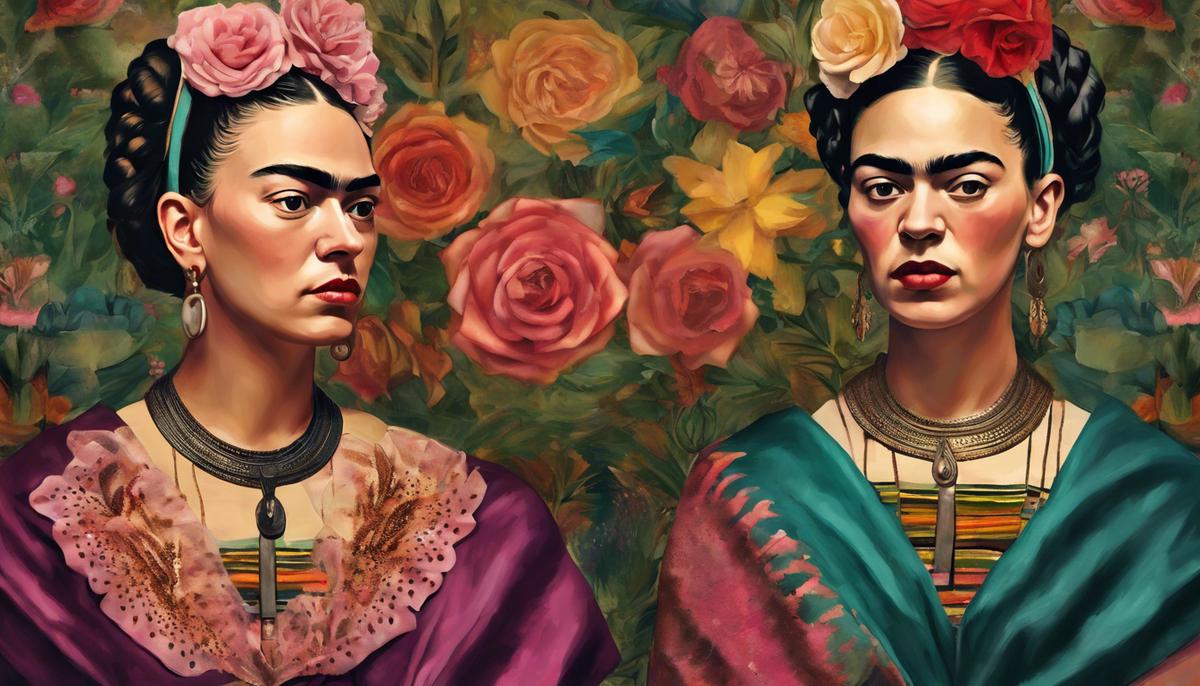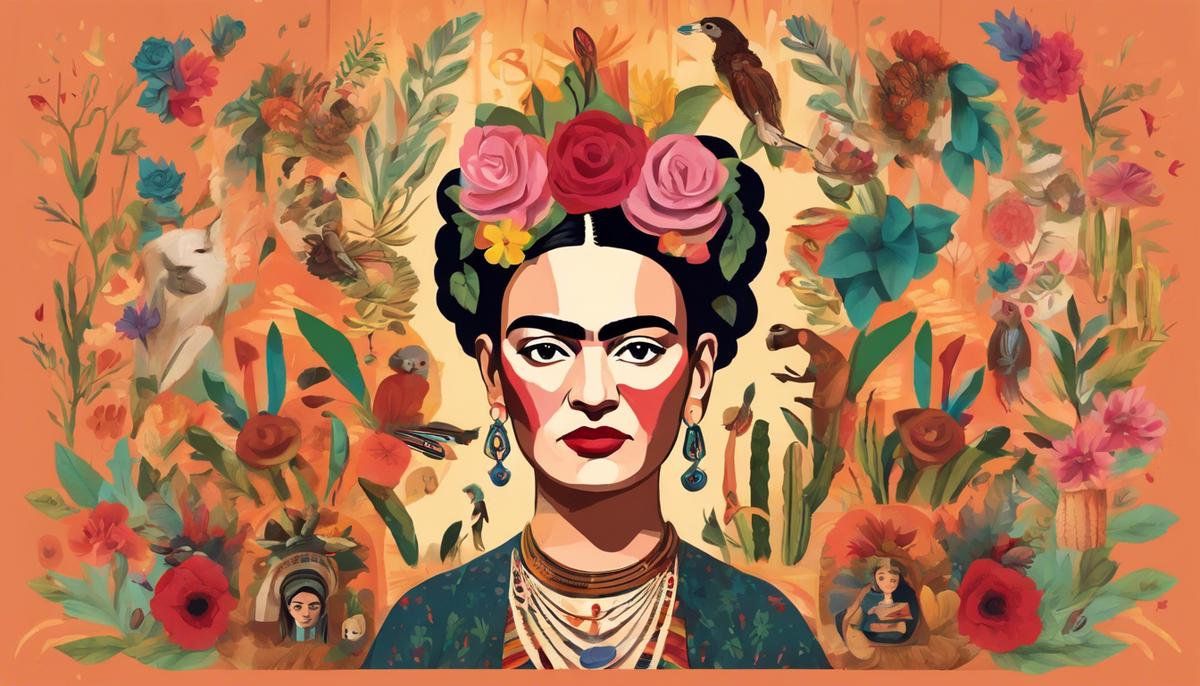Artistic Genesis
Frida Kahlo's journey into the art world was paved with personal struggles and physical pain that deeply influenced her canvas. Overcoming adversity from a young age, a devastating trolley accident at the age of 18 left her bedridden. This period of isolation and suffering was when Kahlo picked up her paintbrush as a means of escape and self-expression. Her complex identity, pain, and relationship with Diego Rivera interweave to form a tapestry that is both surreal and magically real.
Kahlo's tumultuous marriage with Diego Rivera, the famed Mexican muralist, introduced a dynamic intersection between personal turmoil and artistic inspiration. Their relationship, characterized by passion, infidelity, and mutual artistic influence, propelled Kahlo towards themes of identity, betrayal, and love. Her blend of personal iconography and Mexican culture emerged from this union, transforming her pain into potent symbolic imagery on canvas.
Struggling with acute health issues throughout her life, including polio as a child and the lingering consequences of her accident, Kahlo's physical suffering became a central theme in her work. Her vulnerability and resilience found expression through surreal depictions of her bodily pain and emotional turmoil. Kahlo's portrayal of her struggles created an intimate bond with the observer, inviting them into her world of suffering and endurance.
Her survival embodied magical realism, manifesting in works that combined elements of her reality with fantastical invention. These qualities provide insight into Kahlo's internal narrative – one where heartache and physical discomfort are interwoven with vivid, symbol-laden dreamscapes. This distinctive style became a means to navigate the emotional landscapes of her personal tale while resonating a universal appeal.
Central to Kahlo's oeuvre is the recurring integration of motifs drawn from Mexican folk art traditions and pre-Colombian culture, fused with elements from her life. This blending showcases Kahlo's deep engagement with her heritage and her attempt to construct identity through the lens of personal and cultural history. Her use of color, symbolism, and portrayal of autobiographical subjects break through the boundaries between realism and the surreal, adding layers of meaning and engaging audiences in a dialogue about femininity, pain, and resilience.
This interplay between Kahlo's life experiences and her artistic expression underscores the fusion of surrealism with magical realism in her work. Through her vivid brush strokes and the depth of her emotional landscape, Kahlo invites viewers into an intimately surreal world, grounded in the complexities of her existence. Her legacy intertwines the pain and beauty of life, illustrating how art can emerge from suffering to resonate truths universally felt but seldom so captivatingly expressed.

Surrealism & Identity
Kahlo's exploration of identity within surrealism is an intricate dance between personal introspection and broader societal contexts. Her use of surrealistic imagery—where the lines between reality and fiction blur—serves as a mirror reflecting her multifaceted identity. Through her canvases laden with unusual juxtapositions and dream-like sequences, Kahlo embarks on a quest for self-understanding and for challenging societal perceptions of race, gender, and class.
Venturing beyond the personal, Kahlo's art delves into the complexities of being a Mexican woman artist in a predominantly patriarchal society. Her self-portraits become theaters where various aspects of her identity are both the actors and the audience. Each painting reflects layers of meaning, weaving together her physical agony with her cultural pride, feminine strength with vulnerability, illuminating her internal conflict and reconciliation with these overlapping selves. Kahlo's portrayal of herself adorned in traditional Tehuana dresses, for instance, underscores a reclaiming of feminine power and autonomy.
Kahlo's paintings make bold statements on gender roles, offering commentary on the expectations and limitations placed upon women in Mexican society and beyond. By presenting herself in roles and scenarios that defy conventional gender norms—sometimes depicted with symbolic elements of male attire or in positions of strength—Kahlo rejects passive femininity in favor of a more complex, robust interpretation. This defiance married with her visual articulation of pain positions her within a surrealistic domain where identity is fluid and negotiable.
The entanglement with the Mexicayotl movement lends another layer to Kahlo's artistic persona, embedding her work within a narrative that seeks to recuperate and celebrate the pre-Colombian cultural heritage of Mexico. Her paintings serve as a bridge connecting the ancient past with the contemporary, always pointing towards a culturally rich tableau from which she drew significant inspiration. This sense of belonging and pride deeply affected how Kahlo perceived herself and her surroundings, vocabulary that informed her surrealistic engagements. The movement encouraged looking inward for artistic motivation, resonating with Kahlo's penchant for introspection, rendering her body and identity as prime subjects molded by historical, cultural, and intimate contexts.
Through Kahlo's creative praxis, we witness a revolutionary use of surrealism—not as an escape into fantastical realms but as a strategic, stylized commentary on her environment and circumstances. By melding motifs from Mexican folklore with personal allegory and philosophical musings on existence, her paintings become vibrant discourses on identity politics. Problematizing fixed identities, Kahlo's blend of surrealism with magical realist undertones affords a compelling visualization of the fluidity of self. In navigating themes close to her heart and lived experience—of pain, resilience, and the richness of Mexican culture—Kahlo solidifies her legacy as an artist who could intimately converse with her identity in multifarious ways. Her canvases remain iconic cultural texts that dialogue with notions of selfhood elegantly dressed in the enigmatic garb of surrealism, echoing whispers of rebellion, reclamation, and introspective reflection about what it truly means to be Frida Kahlo.

Magical Realism in Kahlo’s Art
Within the rich tapestry of Kahlo's body of work, magical realism emerges not merely as a stylistic choice but as a fundamental bridge between her internal realities and the external world. Kahlo's manipulation of this genre allows her to develop a layered narrative, where the viewer navigates through a reality reimagined and reinvigorated by her vivid imagination and deep-rooted symbolism. This narrative style, deeply personal yet appealing to universal sentiments, showcases her ability to transcend the confines of conventional reality, inviting us into a world where the ordinary is infused with elements of the extraordinary.
Take, for instance, her masterpiece "The Two Fridas," an example of how magical realism operates within her canvas to explore complex themes of identity and duality. Here, the real and the fantastical coalesce as two distinct but interconnected versions of Kahlo sit beside each other, one dressed in traditional Tehuana costume and the other in European attire. The depiction goes beyond the literal representations of her cultural and personal bifurcations; the shared, exposed hearts and the bloodline that connects, then diverges from these hearts encapsulate Kahlo's anguish and isolation following her separation from Rivera. This portrayal of psychological and emotional rifts transcends mere autobiographical recounting through its utilization of magical realism, transforming personal narrative into a universally understood narrative of loss, identity, and healing.
Moreover, in "Self-Portrait with Thorn Necklace and Hummingbird," Kahlo elevates the interplay between suffering and resilience to mythic proportions, embedding her story within a lush, albeit hostile, natural world depicted with an almost reverential attention to detail. The severity of Kahlo against the backdrop of a thorn necklace that inflicts pain, both physical and emotional, symbolizes the burdens she bore. Yet, it is the inclusion of the hummingbird—an omen of good luck in Mexican folklore—and the protective gaze of both a cat and a monkey that introduces an element of magical protection and resilience. This blending of adversarial realities with fantastical elements underscores Kahlo's artistry in magical realism; she captures the pain of existence while hinting at the mystical forces at play in our lives.
Kahlo's "Henry Ford Hospital" further amplifies this narrative technique, where the stark setting of a bed on a barren industrial landscape contrasts with the deeply emotional and symbolic representation of Kahlo's miscarriage. Floating around her are poignant symbols: a fetus, a flower, and anatomical parts, tethered to her by red ribbons as though they are extensions of her being. Through this, Kahlo confronts artists not just as an observer of her personal tragedies but immerses them within a visceral experience that is at once real and metaphorically laden with complexity. This surreal depiction captures a moment of intense personal loss while resonating with themes of grief, fertility, and the unquantifiable emotional toll of such experiences.
The essence of magical realism in Kahlo's art lies in its ability to blend harrowing narratives of pain, identity crises, and cultural exploration with an overarching sense of mystic surrealism. It envisions a realm where the boundaries between the personal and the universal, the literal and the metaphorical, are blurred, reflecting a deeply entrenched resistance to accepting reality at face value. Through her artistry, Kahlo articulates a world where the fantastic becomes a vehicle for discussing the real, a testament to her enduring legacy as a master storyteller who employed magical realism not simply as an artistic style but as a means to challenge, articulate, and transcend her lived realities.

Cultural Impact
Frida Kahlo's indelible mark on Mexican culture and the broader art world is as vivid and intricate as her paintings themselves. Through her brush, she deliberated upon aspects of her personal narrative and wove threads that connected with Mexico's post-revolutionary identity and consciousness. Kahlo's imagery, rich with symbols from Mexican folklore and pre-Hispanic culture, offered a visual lexicon through which to examine and re-invoke the grand tapestry of Mexican antiquity, in which the Mexicayotl movement found resonance.
Her portrayal of traditional symbols and attire, intermingled with personal and universal themes, played a significant role in defining modern Mexican identity. Kahlo became an emblem of cultural resilience and integrity in the wake of colonial influence, providing a frame of reference for embracing one's roots amidst a rapidly globalizing world. She did so not by negating the pain and fracturing which accompanied her personal and national history, but by embracing and incorporating these as central elements of identity, underscoring her role in shaping Mexican aesthetic and cultural narratives.
Beyond the confines of Mexican culture, Kahlo's work laid claim to global art scenes, emerging not merely as representative pieces of Latin American art but as universal inquiries into the human condition. Her confrontation with personal adversities, coupled with her surreal renditions of femininity, sorrow, and resilience, pierced the veils of cultural and geographic borders to resonate with audiences worldwide. Kahlo's art burgeoned into a dialogic space for discussions on identity, feminism, and the assertion of autonomy through creative expression, attributing lasting legacy to her work within feminist debates and movements.
Moreover, her ethereal combination of pain, beauty, and cultural affirmation inspired future generations of artists. Through Kahlo, many found the courage to explore their histories and afflictions in vivid colors and powerful narratives. Her influence bolstered a more inclusive view of art where personal stories, no matter how unconventional or uncomfortable, became celebrated mediums of expression and empathy. This impetus of personal revelation married with cultural commentary has continued to shape artistic endeavors long after Kahlo's era.
The way in which Kahlo's work has been received and interpreted signifies a cultural turn towards understanding art not just as aesthetic or scholarly pursuit but as a mirror reflecting societal constellations and subjective experiences with remarkable depth. It underscored how intertwined an individual story could become with universal themes of love, fear, acceptance, and persistence against adversity.
Today, Kahlo stands not just as an artistic icon, but as a lodestar guiding discussions around cultural identity, post-colonial discourse, and gender politics both























